New Custom Reserves Categories
Val Nav 2020 adds the ability to fully customize your reserves categories, including all the components, relationships, groups, and resource classes. Val Nav will now support complex models with contingent and prospective resources, such as a full PRMS model or company-specific variants thereof, but will also allow simplification – planning groups who don’t split PDP and PUD wells, or SEC-reporting clients who don’t need a P+PDP forecast, can remove any unused categories and go forward with simpler models.
Why custom reserves categories?
Custom reserves categories allow us to address several client-requested features:
- Contingent/prospective resource tracking – By allowing users to extend the reserves category system, we can capture contingent and prospective resources in a more first-class manner. This can be a simplified model (only track contingents, not the sub-classes), or can go down to a full PRMS model.
- Split PUDs and DUCs, and other sub-classes – With completion costs comprising a larger proportion of well capital, some clients wish to split their current PUDs in two classes: true undeveloped PUDs, and DUCs (drilled uncompleted). Custom reserves categories support this, as well as the behind-pipe/shut-in splits for PDNP classes.
- Simplified setup for SEC reporting – Those reporting to the SEC do not necessarily need or want the full set of built-in Val Nav categories. You can now model a simpler system where you have Probable and Possible categories but not the other increments (P+PDP, P+PUD, etc.).
- Alternate systems – Custom reserves categories allow us to support alternate systems of any kind. This can be simplified planning systems (e.g., a single ‘Forecast’ category, or simple ‘Low-Best-High’), internal contingent systems that are variants of PRMS, an ‘AFE’ category for snapshotting approvals, and so on.
See Customize Reserves Categories for more information.
New Reserves Category Features
Most of Val Nav will look and feel the same if you customize your reserves categories – you’ll just see a longer (or shorter) list in most places.
New Summary Panel
The summary panel (or ‘rescat window’) in the bottom left of the application is now filterable. With certain models (e.g., a full PRMS model) the number of categories to work with can be extensive. To make it easier to work with, we have added a new filter mode, which filters the list down to only those categories with inputs:
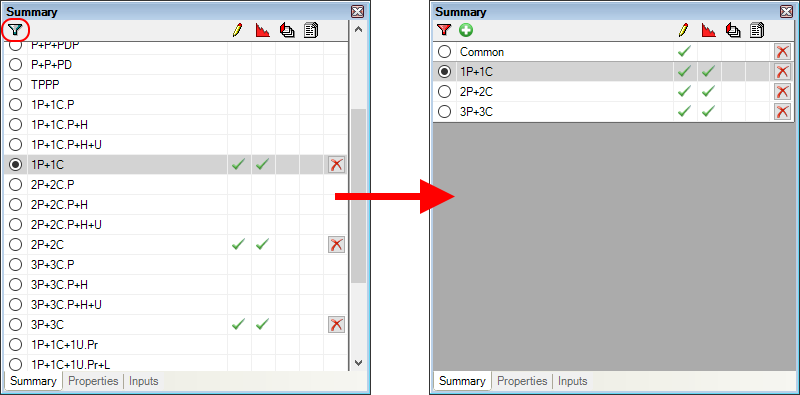
Click image to expand or minimize.
In this mode, a new Add Reserves Category button appears, to offer a convenient way to add new data to the well:
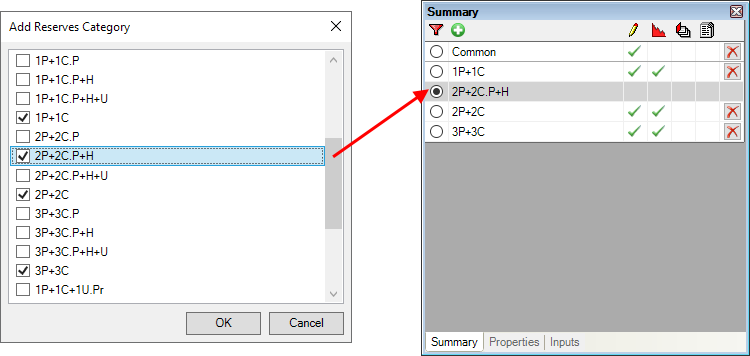
Click image to expand or minimize.
Reserves Category Reporting
Changes to reserves categories will also flow through to reporting. The reports tab and batch manager will let you reference more wedges/related variants:
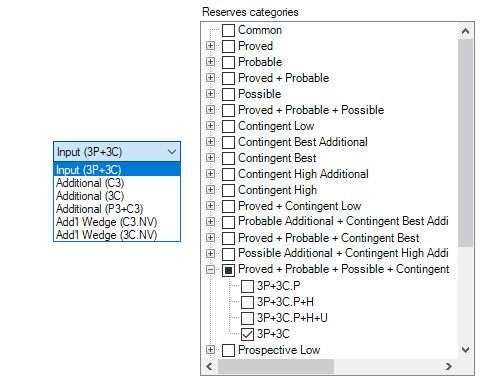
Click image to expand or minimize.
And report content can extend to additional reserves categories:

Click image to expand or minimize.
Balancing and Reporting Reserves
For reserves use, the primary change is around jurisdiction configuration. We split the ‘Reserves Categories to Balance’ option in two: Reserves Categories to Balance, and Reserves Categories to Disclose. This supports workflows where internally companies track resources through to contingent and prospective, but only disclose Proved or Proved + Probable.
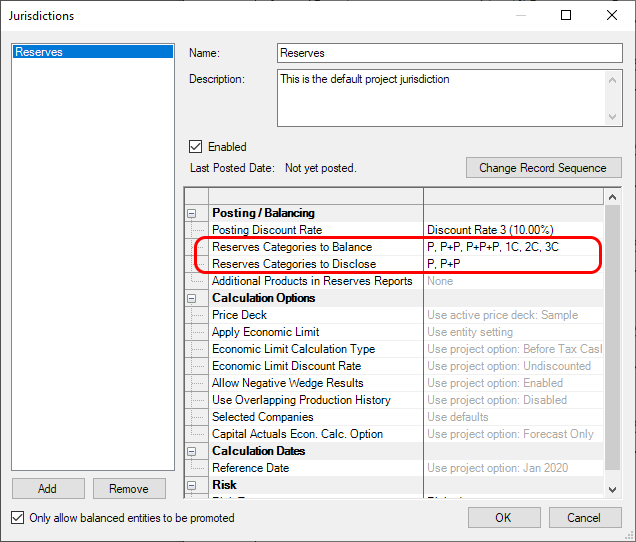
Click image to expand or minimize.
The disclosure option will primarily impact the categories shown on the reports accessible from the Reserves menu, particularly the NI51-101 reports.
All reserves reports have been updated to support alternative reserves category configurations. This may result in minor layout changes (for instance, the Change Record Summary report may now stretch horizontally across multiple pages if you are balancing contingent categories).
Transferring Category Data
The category transfer dialog has been revised to be more flexible. Instead of a fixed list of predetermined transfers, you can now transfer any category to any other, including “untransfering” (e.g., moving a PDP to a PUD). Where applicable, you can still choose to transfer in parallel, meaning your 1P/2P/3P (or 1C/2C/3C and 1U/2U/3U, if you choose to use contingents) can all be moved together.
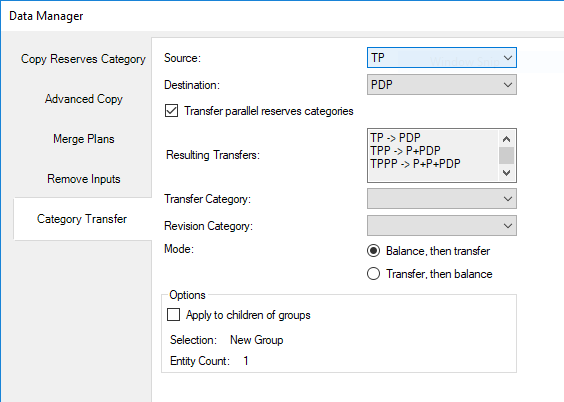
Click image to expand or minimize.
New Type Well Normalization
Val Nav 2020 extends the capabilities of our industry-leading type well tools by adding normalization – scale the analog wells of a type well before calculating the average, and afterwards scale the type well profile back on individual wells to account for completion design.
The ability to normalize means you can expand your population of analog wells. A larger set will yield a more reliable type well. The ability to scale it back to well parameters makes it simple to capture a more accurate forecast for your development plan, or to compare individual wells against their peer average.
Start by looking at normalized data on the cross plots tab to get a statistical look at your sample set and choose appropriate analogs:

You can normalize on any numeric field, whether built-in or one of your project’s custom fields.
The same is then available when creating a type well:

This will flow through to all type well capabilities, including the weighting factors and aggregation type well calculation, and any graphs. Here, the normalized plot is on the right:
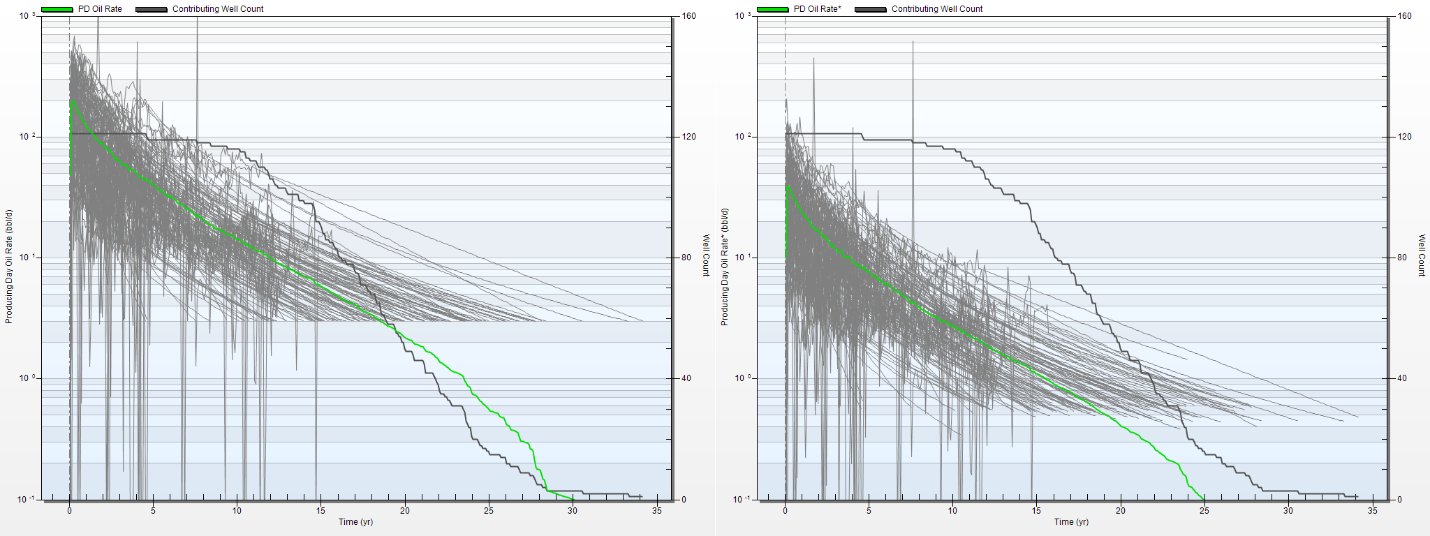
Click image to expand or minimize.
When applying the type curve to wells, you can now scale it based on the normalization, whether in bulk (Tools > Apply/Remove Type Curve):
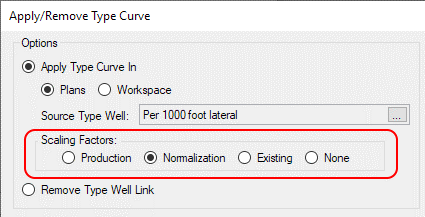
Or on an individual well:
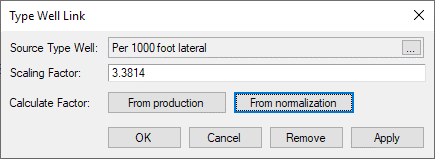
Commingled Groups
To better support certain workflows with commingled production, we have introduced some new capabilities to the group calculation. Groups will now aggregate capital from the child wells, and a new ‘Commingled’ flag has been added to groups that changes the well count calculation from a SUM to a MAX.
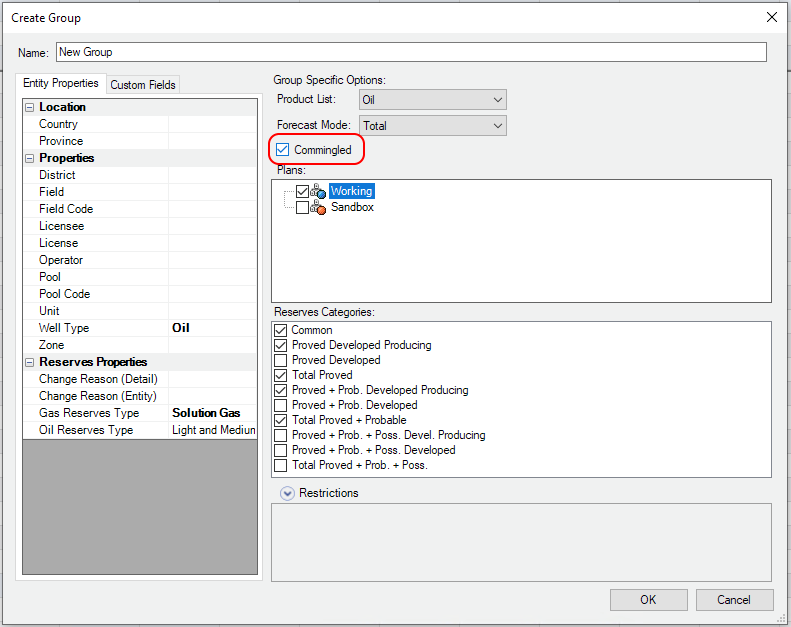
Click image to expand or minimize.
This will allow better behavior for commingled wells around the scheduling of additional completions – the summation of capital means you can keep the completion capital at the well level, and use the project start to move both production and capital in time, and the change to well count means that you will no longer see artificially high well counts at the group level and the corresponding over-allocation of fixed operating costs.
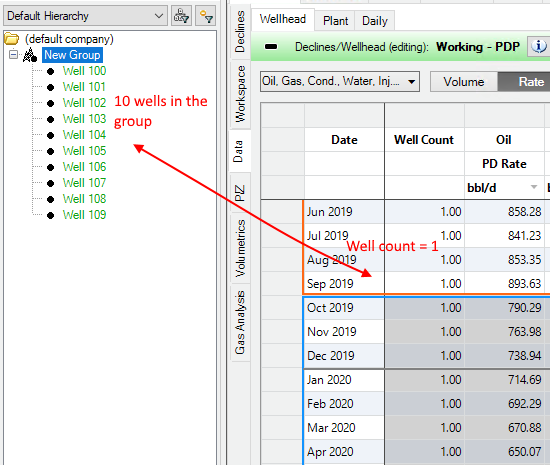
Click image to expand or minimize.
Fit Secondary Ratios
Val Nav 2020 has extended its auto-forecasting algorithm to secondary product ratios, such as gas-oil ratio (GOR), water-oil ratio (WOR), condensate-gas ratio (CGR) and any other built-in or custom-defined ratios for which declines are permitted. This adds yet another level of sophistication and efficiency to Val Nav’s industry-leading capabilities for decline curve analysis and forecasting workflows.
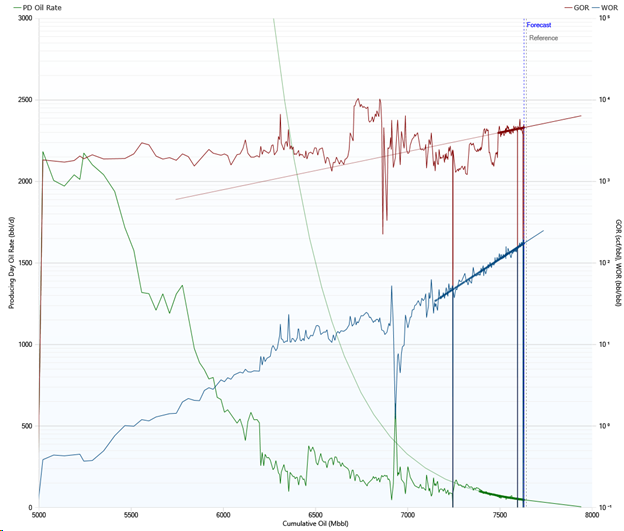
Click image to expand or minimize.
These fits can be triggered in a number of ways:
- Manually alongside regular product fits via the fitting dialog (Predictions > Best Fit and Predictions > Refit)
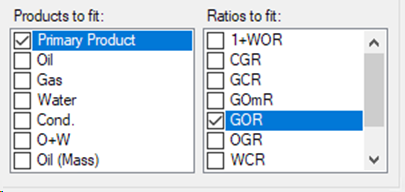
- Via graph interactions (alt-click, ctrl-click, etc., or via right-clicking)
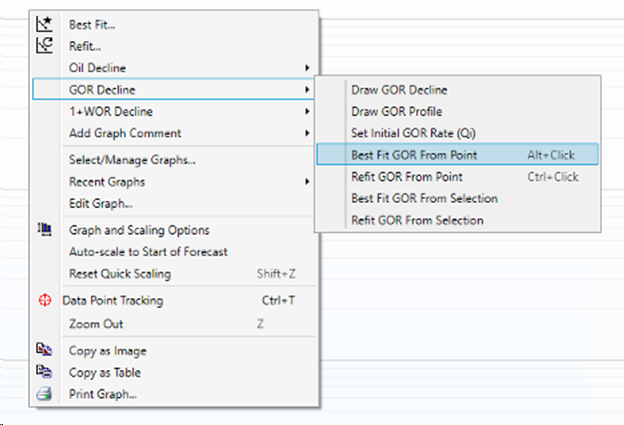
Click image to expand or minimize.
- On import of production data
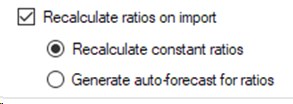
Fit options are available in the user options (Tools > Options > User Options):

Click image to expand or minimize.
Security on the Working Plan
We have extended plan security to the Working plan in Val Nav 2020. This ability to mark Working as only editable by certain users will facilitate better sharing of databases between multiple groups (e.g., Reserves and Planning).
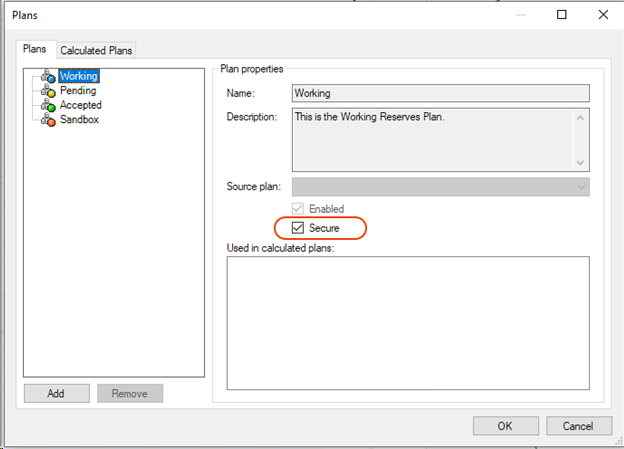
Click image to expand or minimize.
Command-line Spreadsheet Import
We have added command-line parameters for executing imports of spreadsheet data. This extends the existing ability to schedule/automate the import of all types of data, from declines and forecast arrays to ownership and operating costs. This will allow for superior data integration and greatly reduce the need for manual workflows for bringing data in to Val Nav.
Important Schema Change
With the introduction of custom reserves categories, there were some schema changes required. Of particular note is the changing of the reserves category IDs from numeric to string values: new reserves categories will have GUIDs, while the existing categories keep their IDs but in a different data type (e.g., for PDP, the numeric key 1111 will become the string “1111”).
Any integrations or queries against the database may need to be updated. Joins should be fine, but any explicit filtering on reserves category will need to be updated to use the string form of the ID.
Other schema changes are documented separately in the beta download package.
Bug Fixes
The following bugs were fixed in Value Navigator2020:
- Fixed an issue on the Verify Balance report where wells could be sorted in a different order than in the hierarchy.
- Fixed an issue in the auto-reconciliation where a crash could occur if a plan existed in current data that did not exist in the reserves archive.
- Fixed an issue where the hierarchy filter for current-plan entities would show wells with no inputs in the current plan.
- Fixed a crash that could occur in the Decline Workspace when viewing/editing a type well link.
- Fixed an issue with daily fitting where the forecast would sometimes not honour the current month/last production month user option.
- Fixed an issue where daily pressure data would not plot on cumulative graphs in the absence of monthly data.
- Fixed an issue in the decline fitting where the decline parameters could be set to match the max technical life project option instead of the real limit of the well.
- Fixed an issue where an invalid jurisdiction change sequence would yield invalid XML exports. Exported XMLs will now be in a valid form even if the jurisdiction is invalid.
Enhancements
The following enhancements were implemented in Value Navigator 2020:
- Updated reserves category identifiers to use a string instead of a numeric ID
- Reserves category definitions can be now included as part of external project data
- Updated sort ordering of reserves categories throughout the application to respect that configured in the reserves category configuration in global project data. This may yield some changes to sort order in certain reports.
- Updated database storage for type wells to key data by a new "entity rescat" instead of always in PDP (since PDP is no longer guaranteed to exist).
- Added a validation step to XML imports, such that imports of reserves category configuration that would result in the deletion of existing reserves category inputs will be prevented. Reserves category lists must be aligned/compatible before imports can proceed.
- Updated the Wedge/Total labels on the Review|Waterfall tab to reflect that change records can now be configured to store results for non-wedge categories.
- Renamed "PNP" in default reserves categories to "PDNP". Note that this will not impact upgraded databases which will keep 'PNP" name.
- Updated some product default fit settings alongside new default fit settings for fittable ratios.
- Updated default graphs to include autofit series for fittable ratios. Any custom graphs are not upgraded in this manner and will have to be manually adjusted to include the new fit information.
- The spreadsheet import can now be used to import forecast arrays and decline parameters for type wells. This previously was only possible for wells and groups.
- Changed the default user option for default Oracle tablespace to VALNAV_DATA from USERS.
- Changed the economic calculation logic of child plans to remove the fallback logic. Previously, uneconomic results in a child plan would fall back to parent plan results. Child plan economics are now treated as fully independent of the parent.
- Added a new project option (in Project Options: General): Default forecast mode. This will enable you to configure if newly created wells and groups will be in Total or Incremental mode. Previous behaviour was to always default to Incremental mode.
- Added a new project option (in Project Options: General): Last year for technical monthly output. This allows configuring a different monthly/annual split in database results between technical data and economic results, with the goal of improving the accuracy of group and rollup calculations without compromising existing economic result configuration.
- Introduced two new Custom Reporter variables: LastYearForEconomicMonthlyOutput and LastYearForTechnicalMonthlyOutput. Reports using the previous custom report variable LastYearForMonthly will continue to use the economic setting.
- Updated the decline calculation for volume-based ratios, to allow certain calculations to proceed that previously could not be solved.
- Added Oracle 19c to the list of supported database versions.
- Added extension points to the Val Nav extensibility API to support plug-ins providing alternative break-even analysis logic
